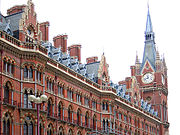
History
Before the 19th century there were few if any large hotels in London.
British country landowners often lived in London for part of the year,
but they usually rented a house if they did not own one, rather than
staying in a hotel. The numbers of business visitors and foreign
visitors were very small by modern standards. The accommodation
available to them included lodging houses and coaching inns.
Lodging houses were more like private homes with rooms to let
than commercial hotels, and were often run by widows. Coaching
inns served passengers from the stage coaches which were the
main means of long distance passenger transport before the
railway network began to develop in the 1830s. The last surviving
galleried coaching inn in London is the George Inn which now
belongs to the National Trust.
A few hotels on a more modern model existed by the early 19th
century. For example Mivart's, the precursor of Claridge's,
opened its doors in 1812, but up to the mid 19th century
London hotels were generally small. In his travel book
North America (1862) the novelist Anthony Trollope remarked
on how much larger American hotels were than British ones.
But by this time the railways had already begun to bring far
more short term visitors to London, and the railway companies
themselves took the lead in accommodating them by building a
series of "railway hotels" near to their London termini.
These buildings were seen as status symbols by the railway companies,
which were the largest businesses in the country at the time,
and some of them were very grand. They included:
Midland Grand Hotel at St. Pancras
* The Midland Grand Hotel at St. Pancras (closed 1935; due to reopen as a Renaissance hotel in 2009/10)
* The Great Western Hotel at Paddington (now the Hilton London Paddington and the first of Britain's railway hotels)
* The Great Northern Hotel at King's Cross (closed for High Speed 1 works and scheduled for demolition and renovation. Will then be used for offices.)
* The Great Eastern Hotel at Liverpool Street (Now the Andaz Liverpool Street)
* The Charing Cross Hotel at Charing Cross station
* The Great Central Hotel at Marylebone (now The Landmark London)
* The Grosvenor Hotel at Victoria

